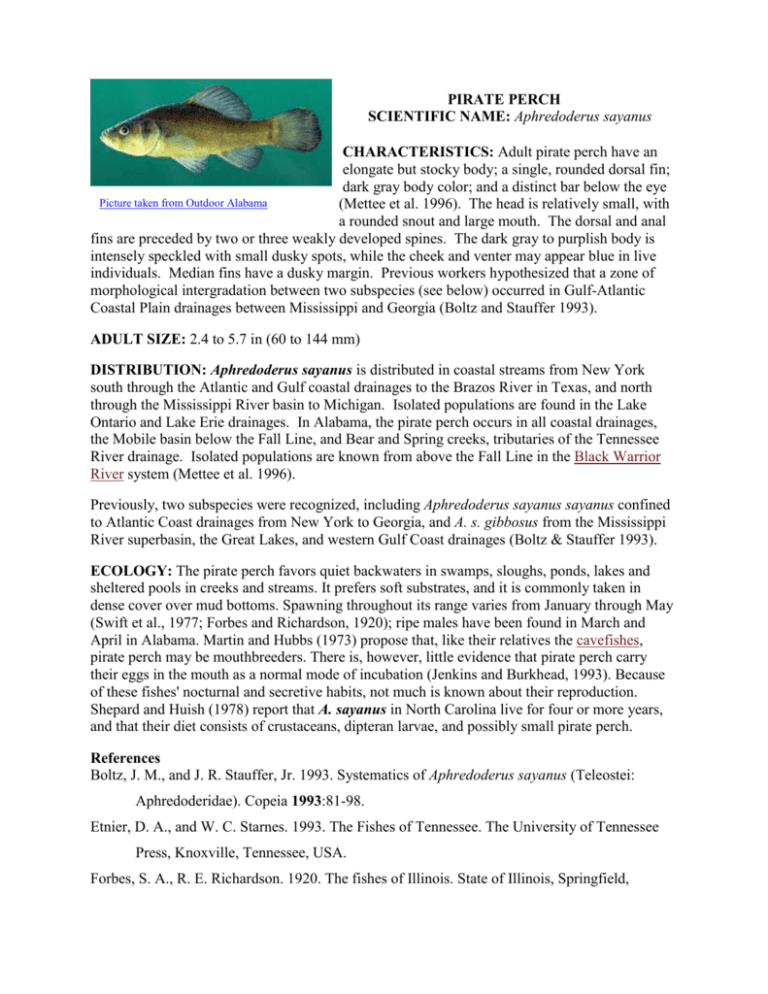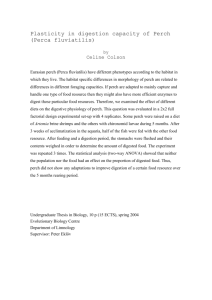Pirate Perch
advertisement

PIRATE PERCH SCIENTIFIC NAME: Aphredoderus sayanus CHARACTERISTICS: Adult pirate perch have an elongate but stocky body; a single, rounded dorsal fin; dark gray body color; and a distinct bar below the eye Picture taken from Outdoor Alabama (Mettee et al. 1996). The head is relatively small, with a rounded snout and large mouth. The dorsal and anal fins are preceded by two or three weakly developed spines. The dark gray to purplish body is intensely speckled with small dusky spots, while the cheek and venter may appear blue in live individuals. Median fins have a dusky margin. Previous workers hypothesized that a zone of morphological intergradation between two subspecies (see below) occurred in Gulf-Atlantic Coastal Plain drainages between Mississippi and Georgia (Boltz and Stauffer 1993). ADULT SIZE: 2.4 to 5.7 in (60 to 144 mm) DISTRIBUTION: Aphredoderus sayanus is distributed in coastal streams from New York south through the Atlantic and Gulf coastal drainages to the Brazos River in Texas, and north through the Mississippi River basin to Michigan. Isolated populations are found in the Lake Ontario and Lake Erie drainages. In Alabama, the pirate perch occurs in all coastal drainages, the Mobile basin below the Fall Line, and Bear and Spring creeks, tributaries of the Tennessee River drainage. Isolated populations are known from above the Fall Line in the Black Warrior River system (Mettee et al. 1996). Previously, two subspecies were recognized, including Aphredoderus sayanus sayanus confined to Atlantic Coast drainages from New York to Georgia, and A. s. gibbosus from the Mississippi River superbasin, the Great Lakes, and western Gulf Coast drainages (Boltz & Stauffer 1993). ECOLOGY: The pirate perch favors quiet backwaters in swamps, sloughs, ponds, lakes and sheltered pools in creeks and streams. It prefers soft substrates, and it is commonly taken in dense cover over mud bottoms. Spawning throughout its range varies from January through May (Swift et al., 1977; Forbes and Richardson, 1920); ripe males have been found in March and April in Alabama. Martin and Hubbs (1973) propose that, like their relatives the cavefishes, pirate perch may be mouthbreeders. There is, however, little evidence that pirate perch carry their eggs in the mouth as a normal mode of incubation (Jenkins and Burkhead, 1993). Because of these fishes' nocturnal and secretive habits, not much is known about their reproduction. Shepard and Huish (1978) report that A. sayanus in North Carolina live for four or more years, and that their diet consists of crustaceans, dipteran larvae, and possibly small pirate perch. References Boltz, J. M., and J. R. Stauffer, Jr. 1993. Systematics of Aphredoderus sayanus (Teleostei: Aphredoderidae). Copeia 1993:81-98. Etnier, D. A., and W. C. Starnes. 1993. The Fishes of Tennessee. The University of Tennessee Press, Knoxville, Tennessee, USA. Forbes, S. A., R. E. Richardson. 1920. The fishes of Illinois. State of Illinois, Springfield, Illinois, USA. Jenkins, R. E., and N. M. Burkhead. 1993. Freshwater fishes of Virginia. American Fisheries Society, Bethesda, Maryland, USA. Martin, F. D., and C. Hubbs. 1973. Observations on the development of pirate perch, Aphredoderus sayanus (Pisces: Aphredoderidae), with comments on yolk circulations patterns as a possible taxonomic tool. Copeia 1973:377-379. Mettee, M. F., O’Neil, P. E., and J. M. Pierson. 1996. Fishes of Alabama and the Mobile Basin. First edition. Oxmoor House, Birmingham, Alabama, USA. Shepherd, M. E., and M. T. Huish. 1978. Age, growth, and diet of the pirate perch in a coastal plain stream in North Carolina. Transactions of the American Fisheries Society 107:457459. Swift, C., Yerger, R. W., and P. R. Parrish. 1977. Distribution and natural history of the fresh and brackish water fishes of the Ochlocknee River, Florida and Georgia. Tall Timbers Research Station Bulletin 20:1-111.











